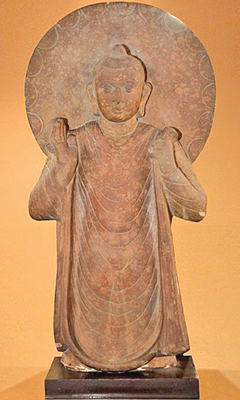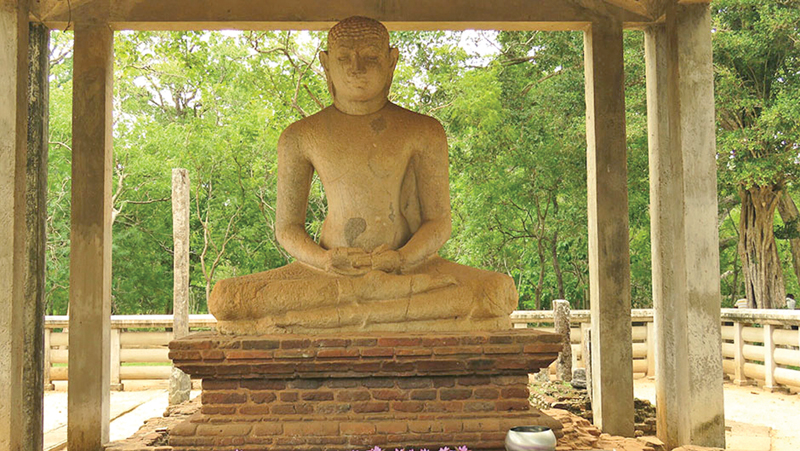 The image of the Buddha has been expressed by artists across centuries in multifarious ways. As one of the biggest spiritual leaders of the world, the image of the Buddha has become a symbolic representation of worship for many Buddhists. But where did this image come from? The rendering we see today, in some parts of the world particularly in Sri Lanka is a manifestation of the 32 marks of a great man, which were common to the Buddha alone.
The image of the Buddha has been expressed by artists across centuries in multifarious ways. As one of the biggest spiritual leaders of the world, the image of the Buddha has become a symbolic representation of worship for many Buddhists. But where did this image come from? The rendering we see today, in some parts of the world particularly in Sri Lanka is a manifestation of the 32 marks of a great man, which were common to the Buddha alone.
The belief that great men were endowed with certain physical characteristics that foretold their greatness was a well-known Vedic concept in ancient India. The Buddha was the epitome of this manifestation and his physical characteristics were praised in many ancient text. However, despite the paeans of admiration on the physical depiction of the Buddha, he was seldom depicted in human form in the earliest art forms found in India. Symbols such as a lotus flower, a wheel, the Bodhi tree, an empty throne or a foot print depicted the presence of the Buddha. The anthropomorphic depiction of the Buddha was considered disrespectful for the ancient Indian artists as they probably didn’t know how to live up to the exalted image described in ancient texts.
It was at Gandhara, an ancient region located in what is now parts of modern-day Pakistan and eastern Afghanistan that the image of the Buddha first emerged. It was a significant cultural and historical area in ancient times, known for its rich contribution to the development of Buddhism and its fusion of Greek and Indian culture, particularly during the Greco-Bactrian and Indo-Greek periods.
The region included cities such as Taxila (in modern-day Pakistan) and Peshawar and its influence extended over a broad area, particularly in the context of art, trade and religion. Gandhara was renowned for the Gandhara art style, which blended Greek and Indian artistic elements, especially in the depiction of the Buddha image.
Alexander’s march to India

Gandhara
Buddha statue
Alexander the Great launched a massive campaign to capture the known world; this quest took him as far as India, the Indian campaign began in 327 BCE and lasted until 325 BCE. Although his rule in India was short-lived, Alexander’s invasion had lasting effects on the region. Once his army retreated, some of his troops stayed back and began to merge with the local population. This gave rise to many Greco Bactrian communities that thrived in this region for many centuries. Seleucus I Nicator, initially controlled Bactria as part of the larger Seleucid Empire, around 250 BCE, the Greco-Bactrian Kingdom began to emerge as a semi-independent kingdom. Diodotus I, the satrap of Bactria, declared Independence from the Seleucid Empire, founding the Greco-Bactrian Kingdom.
Under rulers such as Diodotus II, Euthydemus I and Demetrius I, the Greco-Bactrian Kingdom expanded significantly, conquering parts of Northern India. This area gave rise to a significant Buddhist community, particularly given the successful Buddhist missionaries sent by Asoka the Great in the previous Century. The Indo- Greek communities had a special affinity to Buddhism, given their inquiring minds and inclination to Philosophy. They adhered to the Buddhist teaching and the area flourished with Buddhism given the countless archeological remnants which speak of a prominent Buddhist culture.
Humanisation of the Buddha image
Alfred Foucher (1865–1952) was a French art historian and scholar who is widely regarded as one of the pioneering figures in the study of Greco-Buddhist art. His work on the subject is considered foundational and he made significant contributions to understanding the fusion of Greek and Buddhist artistic traditions in the Gandhara region in his ground breaking study L’Art Greco-Bouddhique du Gandhara’. Foucher is best known for his work in identifying the Greco-Buddhist synthesis—the merging of Greek artistic traditions with Buddhist iconography.
He said that the artistic influence of the Greeks, especially following Alexander the Great’s conquests, played a key role in shaping early representations of the Buddha in the Gandhara region. He emphasised that the Buddhist images created in Gandhara, particularly the human representations of the Buddha, were deeply influenced by Hellenistic sculpture—especially the realistic and idealised depictions of human figures in Greek art. One of Foucher’s most important contributions was how Greek artistic influence contributed to the humanisation of the Buddha in Buddhist art. Prior to Greek influence, the Buddha was represented symbolically but under Greek influence, the Buddha began to be depicted as a human figure. The Greeks had a penchant to worship gods in anthropomorphic forms and began to look for ways to depict the Buddha in a similar manner.
Foucher said that this transition was directly linked to Greek artistic practices, particularly the portrayal of gods and heroes as human figures in a naturalistic style. The Greeks had a tradition of anthropomorphising their deities, which likely influenced the Buddhist representation of the Buddha as an idealised human figure.
Greek influence on Buddhist iconography
It is generally believed that Apollo the Greek god of prophecy, light and male beauty became the prototype for the Greek Buddha image. The Buddha’s face often bears similarities to Greek sculptural traditions, with a serene and youthful expression, an idealised nose and prominent eyes.

Mathura
Buddha statue
The drapery of the Buddha’s robes in Gandhara sculptures also reflect the flowing, naturalistic folds seen in classical Greek sculpture. The halo around the Buddha’s head or mandorla is a clear example of Greek influence in Greco-Buddhist art, linking the Buddha to the tradition of divine imagery in the Greek religion, which became a standard feature in Buddhist art and is thought to have been influenced by the representation of gods and divine figures in Greek and Roman art. Foucher said that such elements were introduced through the direct influence of Greek artisans living in Bactrian and Indo-Greek kingdoms.
The facial features of the Buddha resemble the classical Greek ideals of beauty, characterised by a serene, youthful expression with large, almond-shaped eyes, a straight nose and full lips. These features are similar to those seen in Greek sculptures of gods such as Apollo or Zeus. The idealised facial structure and calm expression used to convey wisdom and tranquility are very much in line with the Greek tradition of portraying divine figures.
The robes of the Buddha in Greco-Buddhist art are depicted in a highly naturalistic style with drapery that flows and falls in graceful, realistic folds. This is characteristic of Greek classical art, where drapery was an important part of the sculpture.
Greek statues of gods often showed finely detailed, flowing robes a hallmark of classical period Greek sculpture. In Gandhara sculptures, the Buddha is shown wearing Hellenistic-style drapery, with fabric flowing in a natural and detailed manner around his body.
This realistic representation of fabric was not common in early Indian art, making it one of the distinct contributions of Greek influence in Gandharan Buddhist art.
Posture and stance
The Buddha is often depicted in a standing or seated posture with highly naturalistic and balanced body proportions, which were influenced by Greek classical sculpture. The posture emphasises elegance and ideal proportion, which was a key characteristic of Greek statuary. For example, the contrapposto pose, which refers to a relaxed, natural standing posture where the weight is shifted onto one leg, often seen in Greek statues such as Venus de Milo and Kritios Boy, can be found in some Greco-Buddhist representations of the Buddha.
Greco-Buddhist art followed the Greek tradition of idealised proportions in human figures. The golden ratio or a similar sense of symmetry was used to create balanced and aesthetically pleasing representations of the Buddha. The focus on proportion and symmetry in these artworks reflects the Greek pursuit of beauty through mathematical harmony in the human form, seen in works such as those of Polykleitos, the Greek sculptor. In Greek Buddhist sculpture the physical characteristics imparted a personality to the Buddha image, a strong yet gentle image of a sage who had transcended the world. This fusion helped shape the visual language of Buddhism in the ancient world and influenced the development of Buddhist art across Asia.
Mathura Art
One of the major centres of early Buddhist art in India, particularly flourishing from the 1st Century BCE to the 3rd Century CE is the Mathura art style known for its distinctive approach to Buddhist imagery, combining Indian traditional artistic techniques with influence from Greek, Persian and Central Asian art, especially through interaction along trade routes such as the Silk Road.
This marked a significant shift in Indian Buddhist iconography, which was previously more symbolic. The Buddha in Mathura art is often shown as a youthful and serene figure, with a gentle, idealised face, symbolic of spiritual enlightenment. These depictions were less influenced by Hellenistic traditions (as seen in Gandhara) and more aligned with traditional Indian artistic ideals. The Buddha’s face in Mathura sculptures tend to be fuller and more rounded compared to the elongated and idealised faces in Gandharan art. The expressions are often calm, with large almond-shaped eyes, arched eyebrows and a smooth, serene face, radiating tranquility and wisdom.
The Mathura-style faces typically have a lesser emphasis on individualism compared to the more naturalistic representations in Gandhara but are highly spiritual and idealised in their representation of divine beauty.
The Samadhi statue
The image of the Buddha as seen in Sri Lanka evolved in a different direction. The Sri Lankan Buddha image reflects a deep connection with the Theravada Buddhist tradition and emphasises the serenity, wisdom and compassion central to the Buddha’s teachings. The evolution of this style over time, from the Anuradhapura to the Kandyan period, shows a progression in refinement and grace, always aiming to reflect the Buddha’s spiritual presence and the ideal of mental peace. Whether in stone, wood or bronze, these statues serve as focal points for worship and meditation, inspiring followers to cultivate wisdom and inner tranquility.
The much-venerated Samadhi statue in the Mahamevnawa Park in Anuradhapura is a profound representation of the Buddha in a moment of deep meditation and spiritual concentration. Through its serene posture and tranquil expression, it encapsulates the Buddhist ideal of mental discipline and meditative absorption, highlighting the Buddha’s journey to enlightenment. It is a depiction of a profound mental state sans the corporeality of the early Buddha images.








